Fermenting Beer with Wyeast 3726 Farmhouse Ale Yeast
Published: October 5, 2025 at 9:59:20 AM UTC
Wyeast 3726 Farmhouse Ale Yeast is a liquid ale strain, highly valued for saisons and farmhouse-style ales. This review delves into the yeast's characteristics: lively attenuation, peppery phenolics, and fruit-forward esters. When used correctly, it offers a unique flavor profile.
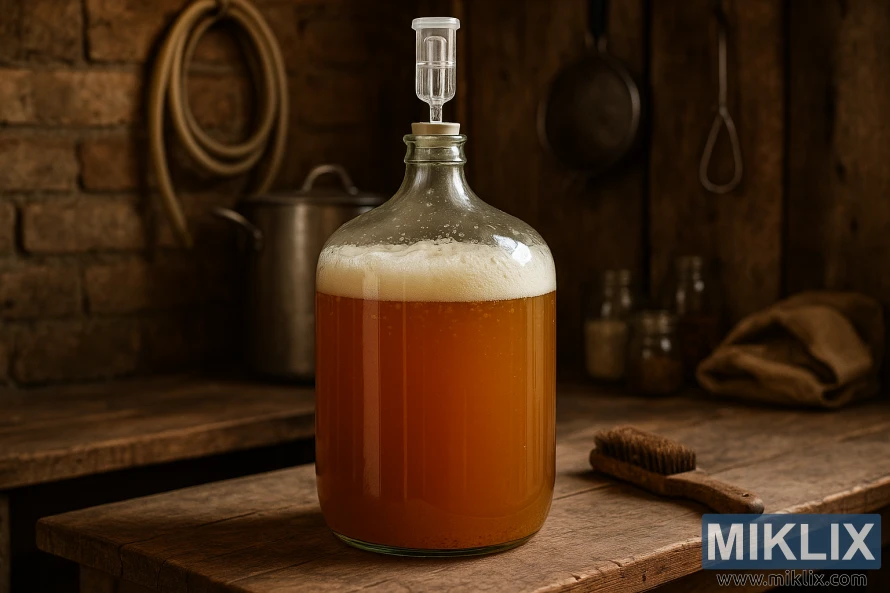
This article serves as a practical guide for fermenting with Wyeast 3726. It covers essential technical specs, starter and pitching tips, and temperature strategies. Troubleshooting is also addressed. Readers will receive advice on building recipes, comparisons with other saison yeast strains, and community-sourced experiences. These insights aim to help homebrewers craft distinctive saisons.
Key Takeaways
- Wyeast 3726 Farmhouse Ale Yeast is tailored for saisons and farmhouse ales.
- Retail listings include detailed specs, customer reviews, and seller guarantees.
- Proper starters and pitching improve attenuation and flavor control.
- Temperature management shapes esters, peppery notes, and dryness.
- This Wyeast 3726 review will guide recipe building and troubleshooting.
Why Wyeast 3726 Farmhouse Ale Yeast Is Popular for Saisons
Wyeast 3726 is celebrated for its lively, rustic character. Brewers seek this yeast for its unique blend of bright esters, earthy, and spicy notes. It offers an aromatic complexity with a dry finish, typical of traditional farmhouse ales.
The sensory profile is slightly tart and dry, finishing with a peppery note. This makes 3726 a top choice for saisons aiming for a refreshing, easy-drinking beer. It captures the gentle tartness and phenolic spice of classic Belgian-style saisons.
Its popularity also stems from practical advantages. Wyeast 3726 ferments quickly at warm temperatures, reaching reliable attenuation. Brewers appreciate its fast activity and short lag times when pitched into warm wort. This efficiency ensures beers finish clean and drinkable, without lingering sweetness.
Comparisons to Dupont-style yeast highlight 3726's unique traits. As a relative, it shares similar ester and spice profiles. Yet, it often ferments faster and shows less tendency to stall during high-activity ferments.
- Ideal uses include traditional saisons and farmhouse ales.
- Great for recipes that call for a dry, peppery, slightly tart finish.
- Pairs well with light malts, pilsner bases, and farmhouse-inspired adjuncts.
Choosing 3726 for saisons offers brewers a reliable route to rustic, aromatic beers. The balance of esters, spice, and dryness ensures freshness and complexity. This avoids the risk of heavy attenuation.
Product overview and specifications for Wyeast 3726
Wyeast 3726 is celebrated for its role in crafting saison-style ales. It offers a wide fermentation window, making it ideal for both homebrewers and professionals. The detailed specs provide a clear roadmap for achieving success with this yeast.
Key technical aspects include the WY3726 fermentation temperature, apparent attenuation, flocculation tendencies, and alcohol tolerance. It ferments cleanly at warm temperatures. The recommended range for traditional farmhouse character is 70–95°F.
- Apparent attenuation: 74–79%, which supports dry finishes in medium-to-high attenuation saisons.
- Flocculation: variable; reports show it can flocculate fairly heavily under some conditions, so clarity may depend on pitching rate and conditioning time.
- Alcohol tolerance: up to 12% ABV, allowing use in higher gravity recipes when managed carefully.
Flavor production is complex, with esters balanced by earthy and peppery notes. It offers a slightly tart, dry profile. This makes it perfect for saisons and farmhouse ales, highlighting spice and subtle fruit.
Wyeast 3726 is available through specialty homebrew retailers. Product pages often include user reviews and substitution suggestions. For a dry alternative, Fermentis Safale US-05 is frequently mentioned. Liquid substitutes vary by brewer preference.
Practical takeaway: Wyeast 3726 supports warm fermentation, significant attenuation, and robust alcohol tolerance. Monitoring flocculation behavior during conditioning is key to controlling clarity and mouthfeel.
Preparing a yeast starter and pitching for success
For reliable saison fermentation, plan a Wyeast 3726 starter when batch gravity is above typical farmhouse range or when using older packs or slurries. A starter is a small malt extract wort that boosts cell count and vigor before you add yeast to the main fermenter. Making yeast starter helps avoid stuck fermentations and gives the culture the head start it needs.
Scale your starter to batch size and original gravity. Use calculators or standard tables to estimate target cell counts. A single 1.040 to 1.060 batch often needs a medium starter. Higher gravities require larger starters or multiple steps. Preparing a healthy Wyeast 3726 starter can shorten lag time and produce more consistent attenuation.
Oxygenation for saison yeast is critical at pitching. Many brewers report better attenuation when they oxygenate with a stone or give a burst of pure O2 at pitching. Good oxygenation supports sterol and membrane synthesis, which helps Wyeast 3726 complete fermentations in higher gravity worts.
Pitching Wyeast 3726 at the right temperature affects flavor and activity. Some brewers pitch warm in the mid to high 70s–80°F to kick-start rapid fermentation. Others pitch cooler in the mid 60s–low 70s and let the beer free-rise to encourage balanced ester production and manage flocculation. Match your pitch strategy to the profile you want from the beer.
- Sanitize equipment and cool starter wort to yeast-safe temperature before adding culture.
- Aerate or oxygenate the main wort after cool-down and immediately before pitching.
- Monitor original gravity and track early gravity drops to confirm active fermentation.
- Keep temperature control consistent during the first 48–72 hours to reduce risk of premature flocculation or stalled attenuation.
Following these steps—making yeast starter tailored to your batch, ensuring proper oxygenation for saison yeast, and selecting a pitch temperature that matches your flavor goals—gives you the best chance of a vigorous, predictable ferment with Wyeast 3726.
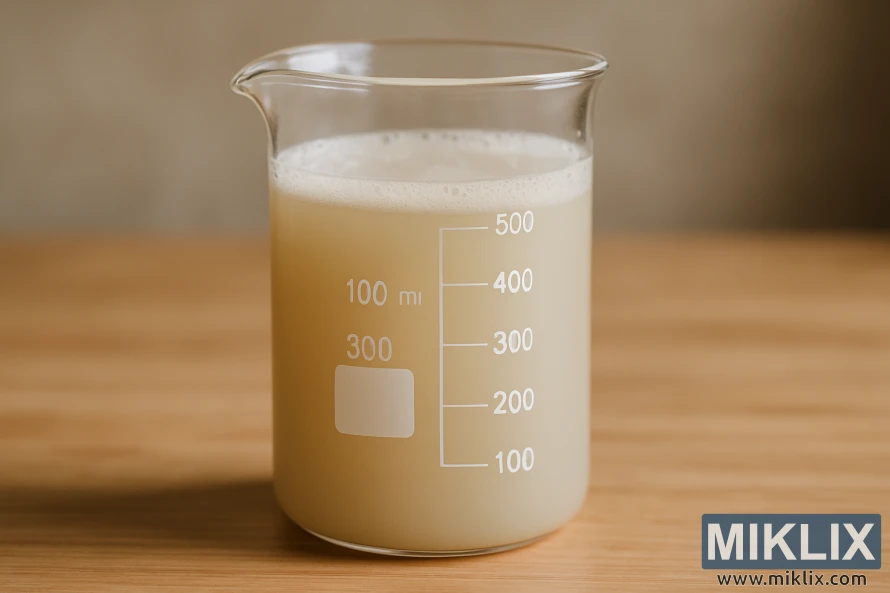
Fermentation temperature strategies
The Wyeast 3726 temperature range is about 70–95°F, but brewers often adjust it for flavor. For saisons, starting cooler and warming up is common. This allows the yeast to develop a complex character.
Many brewers start at around 67°F and then gradually warm it up by a few degrees each day. This method helps achieve balanced esters and peppery phenolics without the harshness of solventy alcohol.
Some brewers prefer a more aggressive approach, starting at 80°F or higher. This method leads to quick fermentation and a strong funk. But, it requires careful control to avoid harsh flavors.
Consistency in temperature is more important than extreme temperatures. Sudden drops in temperature can cause yeast to settle too early, stopping fermentation. Use heating pads, fermentation belts, or temperature-controlled chambers to keep the temperature steady.
Choose a temperature schedule that fits your recipe and equipment. For subtle complexity, start cool and gradually warm up. For bold flavors, start warm but monitor closely to ensure a good final gravity.
Fermentation timeline and expected attenuation
Wyeast 3726's fermentation time varies based on pitch size and temperature. For a typical ~1.060 original gravity, community reports indicate a Wyeast 3726 FG of 1.004–1.007. This reflects saison attenuation at 74–79%.
Fermentation speed can be rapid when yeast is pitched warm and healthy. Some brewers achieve near-final gravities in 4–5 days at high temperatures. On the other hand, schedules starting cool and then warming slowly can extend the total time to 7–21 days.
Several factors influence the timeline, including pitch health, oxygenation, wort gravity, and yeast care. Underpitched or weak yeast will slow fermentation and may stall before reaching expected saison attenuation.
Flocculation behavior also plays a role. Wyeast 3726 tends to drop clear, which can mislead early gravity checks. Wait for stable readings over several days before declaring Wyeast 3726 FG.
- For fast finishes: pitch a robust starter and ferment warm to accelerate 3726 fermentation time.
- For flavor control: start cooler, then ramp up to encourage full saison attenuation without fusel alcohols.
- For high-gravity batches: expect longer fermentation speed and monitor oxygen and nutrient levels closely.
Take gravity readings across multiple days to confirm stability before bottling or kegging. Allow extra conditioning time if the beer finished rapidly. This step helps mellow hot alcohol notes produced during aggressive fermentation.
Flavor development: esters, peppery finish, and tartness
The 3726 flavor profile is centered on lively saison esters, which add fruity notes without dominating the beer. Apple, pear, and citrus hints are layered over subtle farmhouse funk. These complex esters combine with spicy phenolics to create a rich depth.
Temperature management significantly impacts ester and phenolic intensity. Warmer fermentations enhance saison esters and earthy spice, resulting in a rustic, more assertive character. Cooler or controlled ramps, on the other hand, yield a more restrained, balanced yeast expression.
A peppery finish is a hallmark of this beer, lingering on the palate. This peppery finish emerges from the interaction of phenolic compounds with malt and hops. It can either brighten a dry body or sharpen the beer's perceived dryness.
Tart farmhouse flavors manifest as a gentle acidity, not sharp sourness. This light tartness complements the dry finish, making the beer feel clean and refreshing. Bottle conditioning and short aging periods often round and integrate these elements.
Grain bill choices significantly influence how the yeast presents. Higher wheat or pale malt content adds mouthfeel and perceived maltiness while keeping the beer dry. Adjuncts and hop selections interact with saison esters and phenolics, altering balance and aroma.
With careful temperature control, Wyeast 3726 typically produces a dry, slightly tart, peppery saison with moderate fruity esters. Small adjustments in the brewing process can shift the profile from delicate and floral to bold and rustic. This allows brewers to fine-tune the final beer to their liking.
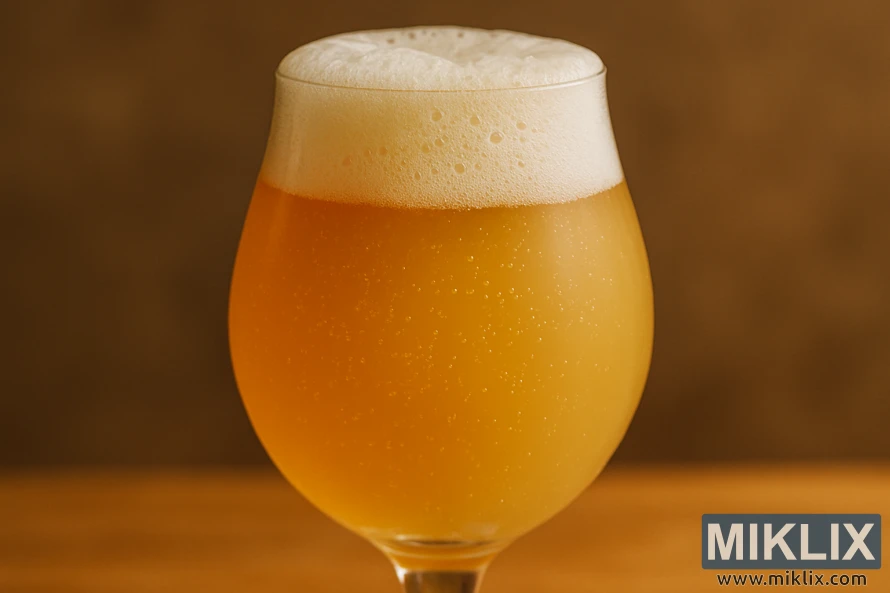
Common fermentation challenges and troubleshooting
Wyeast 3726 problems often manifest as slow activity towards the end of fermentation or unexpected flavors. Brewers might observe airlock bubbles slowing to one every 30 seconds or less. It's essential to take a gravity reading to accurately gauge fermentation progress. Relying solely on airlock activity can conceal stalled fermentation 3726 or a natural decrease in activity.
Stalled fermentation 3726 is rare if you pitch enough healthy yeast and properly oxygenate the wort. If gravity hasn't moved in 48 hours, try increasing the fermenter's temperature slightly to boost yeast activity. Gently agitate the fermenter to resuspend the yeast before taking a gravity sample.
Flocculation issues can arise if the fermentor cools too quickly after krausen drops. Wyeast 3726 tends to flocculate heavily, potentially leading to a higher final gravity than anticipated. To prevent this, use insulation, a heat wrap, or an aquarium heater to maintain the desired temperature during fermentation's final stages.
Alcohol bite or solventy flavors often stem from warm, rapid fermentations. The simplest solution is patience. Cold conditioning and extended bottle or keg conditioning can help soften sharp alcohol esters. If harsh flavors persist, consider a lower pitching temperature and a more gradual temperature increase next time.
Troubleshooting checklist:
- Confirm true gravity with a hydrometer or refractometer corrected for alcohol.
- If stalled, gently warm the fermenter by 3–5°F and swirl to wake yeast.
- Reoxygenate early in fermentation only; avoid oxygen late to prevent oxidation.
- Ensure adequate pitch rate and a healthy starter when brewing high gravity saisons.
- Maintain steady temps after krausen to prevent excessive flocculation issues.
Addressing saison fermentation issues promptly can prevent off-flavors and save batches. Small adjustments can often restore fermentation without drastic measures. Monitor gravity and temperature closely to identify problems early and ensure Wyeast 3726 performs optimally.
Equipment and temperature control tips for homebrewers
Effective temperature control begins with the right equipment. Opt for a dependable heat pad, a Brewbelt, or reptile tape for gentle warmth. Wrap the heater around the fermentor, ensuring the probe area remains uncovered for accurate temperature readings.
Employ a thermowell for precise internal wort temperature monitoring. A stainless thermowell with a probe offers superior readings compared to external sensors. If a thermowell is unavailable, secure an external probe with food-safe tape on the fermenter's side. Insulate around it for consistent data.
Insulation of the fermenter is critical. Glass carboys retain heat better than plastic buckets, which is beneficial for warm fermentations. Use a blanket, jacket, or insulated fermenter wrap to reduce heater usage and stabilize temperature fluctuations.
The choice of controller significantly impacts stability. Opt for a PID or 2-stage controller to minimize cycles and prevent overshooting. Connect your heat pad or reptile tape to the controller, place the probe on a clear fermenter area, set your target temperature, and let the system manage itself. This setup ensures tight temperature control without the need for constant monitoring.
Adopt a straightforward assembly process:
- Clean and position the fermentor.
- Wrap the heating element, ensuring the probe area remains accessible.
- Install a thermowell or attach the probe with tape.
- Connect to a PID or 2-stage controller and set the temperature range.
- Add insulation like a jacket or moving blanket for passive warmth.
Small adjustments can significantly enhance outcomes. Position the probe where the wort level is highest. During the first run, cross-check readings with a spare thermometer. Use moderate heat settings to allow the controller to cycle gently, maintaining fermentation temperature within your desired range.
Recipe building for Wyeast 3726-driven beers
Begin with a clear objective. Aim for a dry, peppery saison by setting the original gravity between 1.050 and 1.065. This range leverages Wyeast 3726's strengths, allowing for the development of fruity esters and spicy phenols.
Construct a grain bill that focuses on pale malts and Pilsner malt as the base. Allocate 70–85% to base malt, then add 5–10% wheat or flaked wheat to enhance mouthfeel. Specialty malts should not exceed 5% to preserve the yeast's distinct character.
When formulating a farmhouse ale recipe, consider adding medium-dry adjuncts like Vienna or light Munich for malt complexity. For a lean, rustic taste, prioritize pale and wheat malts, limiting caramel or roasted grains.
Approach hopping for saison with subtlety. Opt for noble or neutral hop varieties for bitterness and a light floral or spicy aroma. Target moderate IBU levels, usually 20–35, to balance without overpowering the yeast-driven profile.
Consider hop timing to preserve yeast character. Use most hops early for bittering and a small late addition or dry hop for gentle aroma. This method prevents the peppery finish from being overwhelmed by hop oils.
- Grain bill example: 80% Pilsner, 10% pale ale, 8% flaked wheat, 2% pilsner dextrin.
- Hops example: Styrian Golding or Saaz for bittering; small late Saaz addition for aroma.
- OG target: 1.052 for session saison, 1.062 for fuller-bodied saison.
Align your fermentation plan with the recipe. For pronounced esters and phenols, ferment warmer, in the mid-70s°F, and consider a progressive ramp toward the end. For a subtler profile, start cooler in the mid-60s°F and gradually raise temperature to encourage full attenuation.
Consider carbonation early in the recipe design. Traditional saisons benefit from high carbonation. Plan for elevated bottle or keg conditioning volumes to lift the body and showcase dryness and spice.
Lastly, adapt recipes by testing small batches. Keep detailed notes on how changes to the grain bill, hopping, and fermentation profile affect the final beer. Iteration leads to balanced farmhouse ales that highlight Wyeast 3726 without overwhelming its signature character.
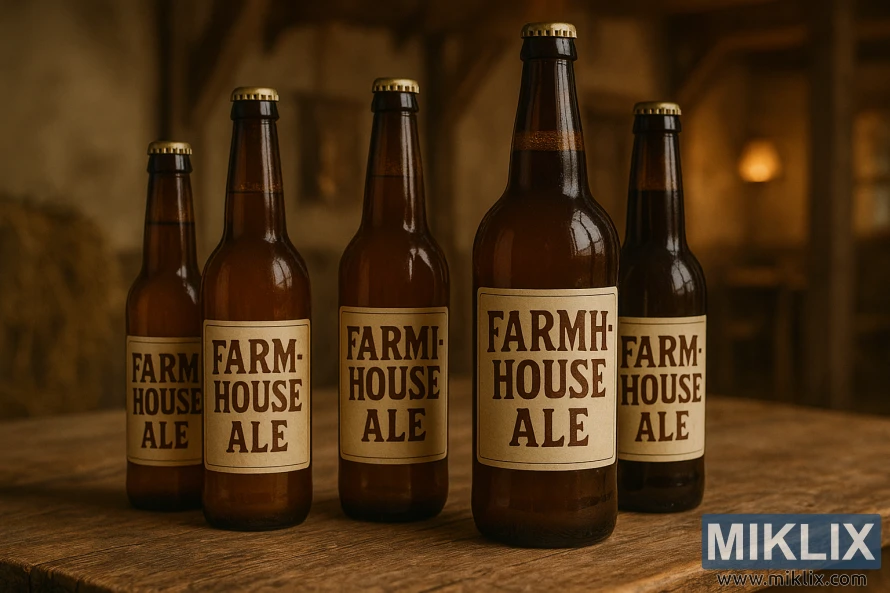
Comparisons and substitutions for 3726
Wyeast 3726 is often compared to Dupont strains due to its peppery and fruity flavors. When tasting both side-by-side, they share phenolic characteristics. Yet, 3726 ferments quicker at warmer temperatures.
Homebrewers looking for alternatives to Wyeast 3726 face trade-offs. Wyeast 3711 offers a clean, estery profile with high attenuation. On the other hand, Wyeast 3724 leans towards farmhouse funk and slower maturation. Each strain provides a unique balance of esters, phenols, and dryness.
When liquid 3726 is not available, some suggest using US-05 as a dry substitute. This results in a cleaner, less funky beer with fewer phenolics and a neutral backbone.
Practical guidance for swapping strains:
- Adjust fermentation temperature to coax desired flavors from the substitute.
- Increase or decrease pitch rate to alter ester production and attenuation.
- Anticipate changes in final dryness and mouthfeel when moving away from 3726.
For recipe tweaks, slightly raise fermentation temperature with cleaner strains to encourage esters. With funk-forward strains, slow rises and warmer finishes enhance complexity. Brewers using US-05 substitution should add saison-style fermentation schedules for more character.
Compare timelines and taste outcomes before committing to a full batch. Small test batches allow you to gauge how each alternative affects aroma, pepper, and finish without risking a large volume of beer.
Alcohol tolerance and high gravity fermentations
Wyeast 3726's alcohol tolerance is up to about 12% ABV, making it a great choice for saisons with high gravity. Brewers aiming for a high gravity saison can count on 3726 to handle elevated alcohol levels. This is provided they offer the right support.
When aiming to ferment above 1.070, it's wise to plan for a larger starter or use multiple packs. This increases viable cell counts. Strong cell growth aids in sugar metabolism and lowers the risk of stalled fermentation in rich worts.
Ensure thorough oxygenation at pitching. Adequate oxygen enhances sterol and membrane formation. This improves yeast performance in high gravity saisons and prevents sluggish activity.
- Scale the starter to match the target OG, not just pale ale rules of thumb.
- Pitch actively fermenting yeast when possible to add vitality.
- Use pure oxygen or extended aeration to reach higher dissolved oxygen levels for big beers.
Temperature control is key. Maintain a warm, steady fermentation temperature to encourage full attenuation. This helps the yeast finish cleanly at the target final gravity. A slight warming of the fermenter during the high-activity phase can help 3726 overcome tougher sugars.
Be mindful of alcohol bite in young beer brewed near the 3726 ABV limit. Harshness often mellow out with weeks of conditioning. Patience and proper maturation will reduce solvent notes, allowing farmhouse character to emerge.
For success, scale the starter based on estimated pitching rate, oxygenate the wort thoroughly, and maintain stable temperatures. Monitor gravity to confirm the yeast is finishing. These steps enhance the chances of a robust fermentation when fermenting above 1.070 and nearing the 3726 ABV limit.
Conditioning, bottling, and using 3726 for bottle conditioning
Only plan your packaging once fermentations have stabilized over several days. This step is critical to avoid overcarbonation and stalled bottles. Relying on Wyeast 3726 for natural carbonation is a key part of this process.
For those who value clarity, cold crashing can help. This method drops yeast and particulates, making it easier to reuse slurry for priming or to harvest healthy yeast for future batches.
When it comes to carbonation levels, saisons can vary. Traditional saisons aim for 3.0–4.5 volumes of CO2. To achieve this, you can use priming sugar or keg conditioning, depending on your preference.
- Use a priming calculator to ensure consistent results.
- Consider corn sugar for predictable outcomes or Belgian candi sugar for style nuance.
- Ensure bottles are intact and caps are sealed before storing them for conditioning.
Allow bottles time to mature. Hot alcohol notes often mellow after a month, with flavors integrating over additional weeks. Patience is key when using 3726 conditioning in a saison.
To save yeast, preserve a healthy cake from Wyeast 3726 under sanitary conditions and refrigerate it. Properly stored slurry can be reused for priming or repitched into future batches. This approach saves costs and preserves strain character.
Follow a brief packaging checklist: stable FG, optional cold crash, measured priming sugar, and sanitized bottles. This routine ensures reliable carbonation with saison yeast and consistent results with Wyeast 3726 across batches.
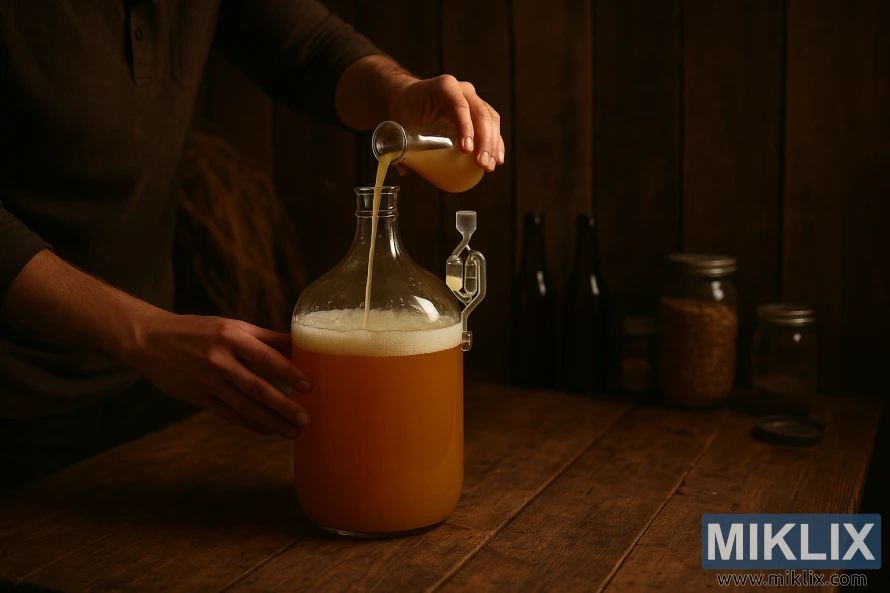
User reviews and community experiences with 3726
Homebrewers on forums and Facebook groups share many Wyeast 3726 reviews. They highlight rapid fermentations when the yeast is pitched warm. Several accounts describe finishing a 1.060 OG batch down to about 1.004–1.007 in as little as four days. These speed reports show why some brewers pick 3726 for quick turnaround saisons.
Threads with 3726 community feedback reveal a mix of temperature tactics. Some brewers pitch at about 80°F for a fast start and bold ester profile. Other posts recommend starting near 67°F, then raising to the mid-70s to temper phenolics while preserving dryness. Both methods have advocates who report solid results.
Readers report varied saison yeast experiences in tasting notes. Common descriptors include funky, tart, and very dry with a pleasing mouthfeel when a larger portion of wheat is used. A few brewers mention a noticeable alcohol warmth on young bottles that mellows after weeks of conditioning.
Practical endorsements appear often in community posts. Many users call 3726 their house saison yeast for its reliable attenuation and consistent bottle-conditioning. Some caution that uneven temps can trigger premature flocculation, so consistent fermentation control is a recurring tip in the feedback.
- Fast fermentation examples: multiple reports of OG ~1.060 to FG ~1.004–1.007 in days.
- Temperature approaches: warm pitch versus cool start with a gradual ramp.
- Flavor outcomes: tartness, funk, dryness, and good mouthfeel with higher wheat.
- Practical notes: favorite strain for many, but watch for flocculation from temp swings.
- Availability: several brewers buy extra packs ahead of seasonal shortages.
The balance of Wyeast 3726 reviews, 3726 community feedback, and saison yeast experiences paints a picture of a flexible, fast-acting strain. Brewers who match pitch rates, temperature plans, and recipe choices to their goals tend to report the best outcomes.
Best practices for storing and reusing Wyeast 3726 slurry
Harvest the slurry after bottling or kegging, when the yeast is active. Use sanitized containers to keep cells healthy. Refrigeration at 34–38°F is ideal for short-term storage.
Label jars with the date and batch source. This helps track age and origin for timely refreshment. Brewers often refresh yeast after a few uses to maintain quality.
Estimate cell counts for high-gravity beers. Build a starter from the slurry if needed. Wyeast 3726 performs well from healthy slurry but viability decreases over time.
Follow strict sanitation to avoid contamination. Slurry from mixed fermentations or bottle-conditioned saisons may contain harmful bacteria or Brettanomyces. Be cautious when saving yeast from non-sterile or mixed-culture beers.
Refresh older slurry with a small starter before pitching. If storage exceeds a few months, revive the slurry. Check aroma and activity before reusing. These practices enhance fermentation reliability.
- Collect immediately after transfers to minimize oxygen exposure.
- Store cold in sanitized, airtight containers for short-term use.
- Label date, source, and estimated cell count for each jar.
- Make a starter when targeting high-gravity or long ferments.
- Discard slurry showing off odors or visible contamination.
Many homebrewers save slurry when Wyeast 3726 is out of stock seasonally. Saving yeast or buying extra packs ensures strain consistency. Good record keeping and regular refreshment make reusing slurry reliable for consistent saisons.
Conclusion
Wyeast 3726 summary: This farmhouse ale strain is perfect for saisons and rustic farmhouse ales. It offers high attenuation, complex esters, a peppery finish, and a touch of tartness. Its reliable bottle-conditioning and clean fermentation under varied temperatures make it ideal for brewers aiming for dry, expressive beers.
Key operational points include preparing a suitable starter for higher gravities and oxygenating the wort at pitching. Choose a temperature strategy that aligns with your flavor goals. A cooler start with a gradual ramp favors restrained esters, while a warmer pitch speeds fermentation and enhances peppery notes. Always monitor gravity, not airlock activity, to gauge fermentation completion.
Practical considerations include storing and reusing slurry with care and maintaining temperature control to avoid premature flocculation. Allow conditioning time to soften any hot alcohol. Expect rapid finishes under warm conditions but plan extra time for balance development in the bottle or keg.
For homebrewers looking for an expressive saison yeast recommendation, fermenting with 3726 is a clear choice. When paired with thoughtful pitching, oxygenation, and temperature management, Wyeast 3726 is a versatile, proven option. It's worth considering for anyone crafting saison recipes or exploring mixed-fermentation blends.
Further Reading
If you enjoyed this post, you may also like these suggestions:
- Fermenting Beer with Fermentis SafLager S-189 Yeast
- Fermenting Beer with Bulldog B44 European Ale Yeast
- Fermenting Beer with CellarScience Saison Yeast
